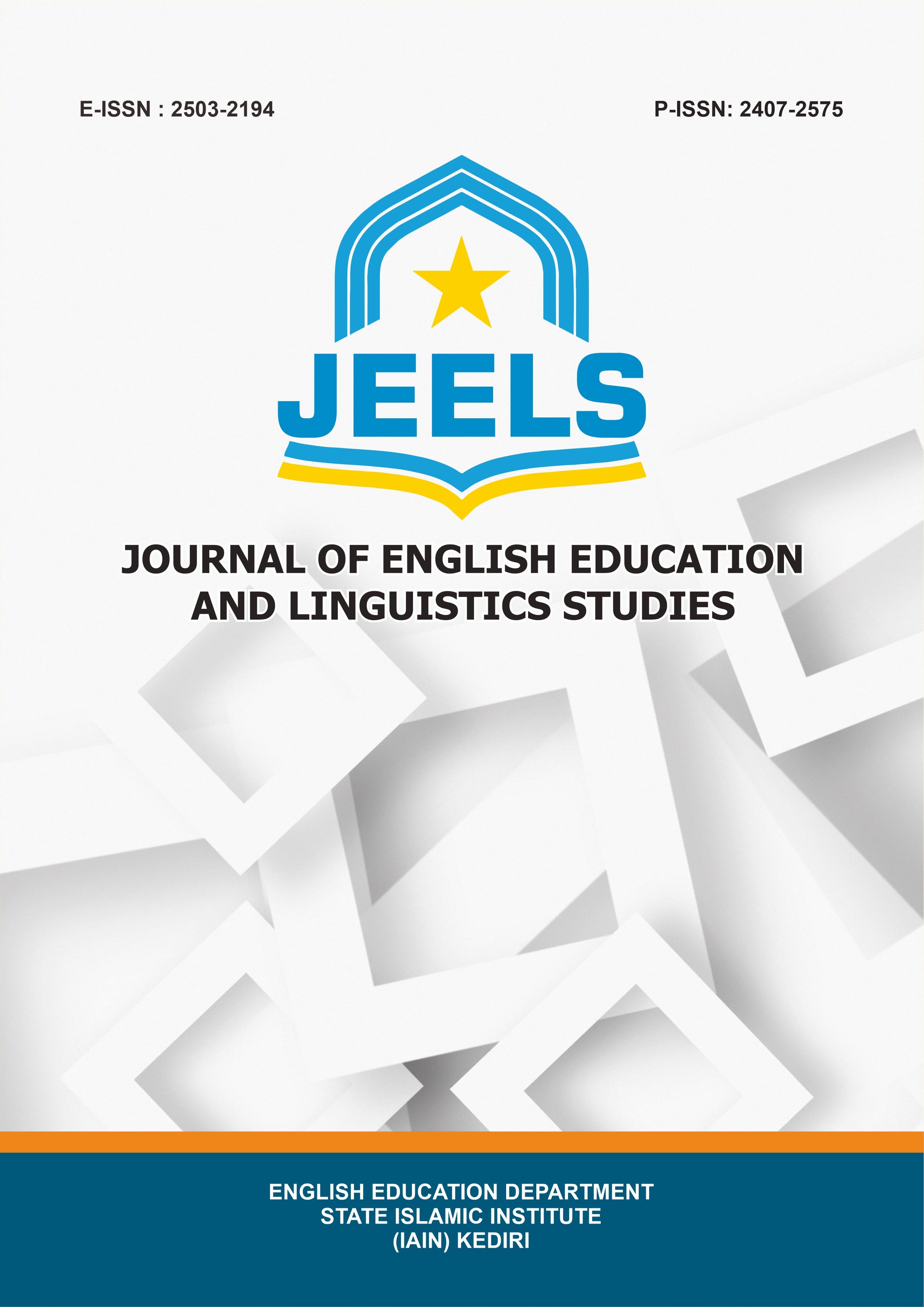Investigating the Impact of CALL on EFL Students' Speaking Skills at Islamic Boarding School: A Mix-Method Approach
DOI:
https://doi.org/10.30762/jeels.v12i1.3800Keywords:
Computer-Assisted Language Learning (CALL), EFL students, Islamic boarding school, speaking fluency, speaking confidenceAbstract
This study examines the impact of computer-assisted language learning (CALL) on speaking fluency and confidence among EFL students at Al-Mizan Islamic Boarding School in Indonesia. A mixed-method approach was employed, with quantitative data collected through pre-tests and post-tests and qualitative data through interviews and observations. Speaking fluency was measured based on speech flow, pace, continuity, naturalness, and intonation, while confidence was measured based on willingness to participate, composure, eye contact, vocal clarity, and engagement. Results revealed significant improvements, with the average fluency score increasing from 55.46 to 75.67 and confidence score from 58.63 to 80.58 after an eight-week CALL intervention. Qualitative findings highlighted that CALL’s interactive features and real-time feedback supported students in improving their pronunciation and reducing speaking anxiety. This study underscores the effectiveness of CALL in enhancing speaking proficiency and fostering learner autonomy, particularly in EFL contexts with limited speaking opportunities. While the findings are promising, future research with larger samples and extended intervention periods is recommended to examine the long-term impacts of CALL. These results advocate for integrating CALL into language education to create more engaging and supportive learning environments that promote fluency and confidence development in EFL learners.
Downloads
References
Abdallah, M. M. S. (2019). EFL/TESOL methodology 2: Advanced language teaching/learning strategies (2nd ed.). Faculty of Education, Assiut University, Egypt. (ERIC Number: ED596113)
Adara, R. A., & Haqiyah, A. (2021). Improving Indonesian EFL learners’ motivation through computer assisted learning (CALL). Journal of English Language Studies, 6(1), 110-121. https://doi.org/10.30870/jels.v6i1.9119
Ahmed, S. T. S., Qasem, B. T. A., & Pawar, S. V. (2020). Computer-assisted language instruction in South Yemeni context: A study of teachers’ attitudes, ICT uses and challenges. International Journal of Language Education, 4(1), 59-73. https://doi.org/10.26858/ijole.v4i2.10106
Aizawa, I., Rose, H., Thompson, G., & Curle, S. (2023). Beyond the threshold: Exploring English language proficiency, linguistic challenges, and academic language skills of Japanese students in an English medium instruction programme. Language Teaching Research, 27(4), 837-861. https://doi.org/10.1177/1362168820965510
Akter, N., Alim, S., Khalid, A., & Ahmad, H. (2022). “Student-centered” versus “teacher-centered” teaching in human anatomy: correspondence. In Surgical and Radiologic Anatomy 44(4), 501–502. https://doi.org/10.1007/s00276-022-02922-x
Alharbi, S. H. (2021). The Struggling English Language Learners: Case Studies of English Language Learning Difficulties in EFL Context. English Language Teaching, 14(11), 108-117. https://doi.org/10.5539/elt.v14n11p108
Aljameel, I. H. (2022). Computer-assisted language learning in Saudi Arabia: past, present, and future. International Education Studies, 15(4), 95-107. https://doi.org/10.5539/ies.v15n4p95
Al-khresheh, M. H. (2024a). Bridging technology and pedagogy from a global lens: Teachers’ perspectives on integrating ChatGPT in English language teaching. Computers and Education: Artificial Intelligence, 6(2), 1-12. https://doi.org/10.1016/j.caeai.2024.100218
Bahari, A. (2021). Computer-assisted language proficiency assessment tools and strategies. Open Learning, 36(1), 61-87. https://doi.org/10.1080/02680513.2020.1726738
Baker, W., & Sangiamchit, C. (2019). Transcultural communication: language, communication and culture through English as a lingua franca in a social network community. Language and Intercultural Communication, 19(6), 471-487. https://doi.org/10.1080/14708477.2019.1606230
Balula, A., Vasconcelos, S., & Moreira, A. (2021). Digital platforms in the age of mobility: a contribution towards language teaching and learning. Communications in Computer and Information Science, 1384, 398-407. https://doi.org/10.1007/978-3-030-73988-1_32
Chen, M. R. A., & Hwang, G. J. (2020). Effects of a concept mapping-based flipped learning approach on EFL students’ English speaking performance, critical thinking awareness and speaking anxiety. British Journal of Educational Technology, 51(3), 817-834. https://doi.org/10.1111/bjet.12887
Chen, Y. chen. (2024). Effects of technology-enhanced language learning on reducing EFL learners’ public speaking anxiety. Computer Assisted Language Learning, 37(4), 1-25. https://doi.org/10.1080/09588221.2022.2055083
Coppinger, L., & Sheridan, S. (2022). Accent anxiety: an exploration of non-native accent as a source of speaking anxiety among English as a foreign language (EFL) students. Journal for the Psychology of Language Learning, 4(2), 1-20. https://doi.org/10.52598/jpll/4/2/6
Creswell, J. W., & Creswell, J. D. (2018). Research Design: Qualitative, Quantitative, and Mixed Methods Approaches (5th ed.). Sage Publications
Dervić, D., Glamočić, D. S., Gazibegović-Busuladžić, A., & Mešić, V. (2018). Teaching physics with simulations: Teacher-centered versus student-centered approaches. Journal of Baltic Science Education, 17(2), 288-299. https://doi.org/10.33225/jbse/18.17.288
Dippold, D., Bridges, S., Eccles, S., & Mullen, E. (2019). Taking ELF off the shelf: developing the students’ speaking skills through a focus on English as a lingua franca. Linguistics and Education, 54, 1-23. https://doi.org/10.1016/j.linged.2019.100761
Enayati, F., & Gilakjani, A. P. (2020). The impact of computer assisted language learning (CALL) on improving intermediate EFL learners’ vocabulary learning. International Journal of Language Education, 4(1), 96-112. https://doi.org/10.26858/ijole.v4i2.10560
Farid, A., & Lamb, M. (2020). English for da’wah? L2 motivation in Indonesian pesantren schools. System, 10(2), 1-19. https://doi.org/10.1016/j.system.2020.102310
Felker, E. R., Klockmann, H. E., & De Jong, N. H. (2019). How conceptualizing influences fluency in first and second language speech production. Applied Psycholinguistics, 40(1), 1-26. https://doi.org/10.1017/S0142716418000474
Fischer, I. D., & Yang, J. C. (2022). Flipping the flipped class: using online collaboration to enhance EFL students’ oral learning skills. International Journal of Educational Technology in Higher Education, 19(1), 1-24. https://doi.org/10.1186/s41239-022-00320-2
Girwidz, R., & Kohnle, A. (2021). Multimedia and digital media in physics instruction. In Challenges in Physics Education, 297-336. https://doi.org/10.1007/978-3-030-87391-2_11
Haim, O., & Tannenbaum, M. (2022). Teaching English to multilingual immigrant students: understanding teachers’ beliefs and practices. Teachers and Teaching: Theory and Practice, 28(4), 1-20. https://doi.org/10.1080/13540602.2022.2062737
Hameed, P. F. M. (2020). Learner-centered language learning strategy in digital environment: its effect to students’ vocabulary, collaboration and independence. TESOL International Journal, 15(4), 102-123.
Hanafiah, W., Aswad, M., Sahib, H., Yassi, A. H., & Mousavi, M. S. (2022). The impact of CALL on vocabulary learning, speaking skill, and foreign language speaking anxiety: the case study of Indonesian EFL learners. Education Research International, 2022, 1-13. https://doi.org/10.1155/2022/5500077
Hirai, A., & Kovalyova, A. (2023). Using speech-to-text applications for assessing English language learners’ pronunciation: A comparison with human raters. In English Language Education 31, 337-355. https://doi.org/10.1007/978-3-031-27825-9_17
Islam, M. S., & Stapa, M. B. (2021). Students’ low proficiency in spoken English in private universities in Bangladesh: reasons and remedies. Language Testing in Asia, 11(1), 1-31. https://doi.org/10.1186/s40468-021-00139-0
Jiang, M. Y. C., Jong, M. S. Y., Lau, W. W. F., Chai, C. S., & Wu, N. (2023). Exploring the effects of automatic speech recognition technology on oral accuracy and fluency in a flipped classroom. Journal of Computer Assisted Learning, 39(1), 125-140. https://doi.org/10.1111/jcal.12732
Kuddus, K. (2022). Artificial intelligence in language learning: Practices and prospects. In Advanced Analytics and Deep Learning Models, 1-17. https://doi.org/10.1002/9781119792437.ch1
Lee, J. S., & Lee, K. (2019). Perceptions of English as an international language by Korean English-major and non-English-major students. Journal of Multilingual and Multicultural Development, 40(1), 1-14. https://doi.org/10.1080/01434632.2018.1480628
Margolis, A. A. (2020). Zone of proximal development, scaffolding and teaching practice. Cultural-Historical Psychology, 16(3), 15-26. https://doi.org/10.17759/chp.2020160303
Masyhud, A., Maruf, N., & Asari, S. (2023). The effectiveness of mobile collaborative learning on students’ writing performance by implementing magnet summary strategy. JET ADI BUANA, 8(01), 1-14. https://doi.org/10.36456/jet.v8.n01.2023.7036
Menggo, S., Suastra, I. M., Budiarsa, M., & Padmadewi, N. N. (2019). Needs analysis of academic-English speaking material in promoting 21 st century skills. International Journal of Instruction, 12(2), 739-754. https://doi.org/10.29333/iji.2019.12247a
Meniado, J. C. (2023). Digital Language Teaching 5.0: Technologies, trends and competencies. RELC Journal, 54(2), 461-473. https://doi.org/10.1177/00336882231160610
Muhajir, A. (2022). Inclusion of pluralism character education in the islamic modern boarding schools during the pandemic era. Journal of Social Studies Education Research, 13(2), 196-220.
Muhammad Chairil Imran, Khaliq Bashar, Budiarti Putri Uleng, Nina Ariani, Sukmawati, Suharti Siradjuddin, Sujarwo, & Irman. (2022). The impact of computer assisted language learning (CALL) technology on Indonesian learners’ speaking skills. IJOLEH : International Journal of Education and Humanities, 1(2), 183–189. https://doi.org/10.56314/ijoleh.v1i2.83
Mustapa, K., Bin Mahmudin Gagaramusu, Y., Hesline Palandi, E., W Syakhrani, A., & Towpek, H. (2023). Technology-enhanced education: nurturing the digital generation-experiences in islamic schools in Indonesia. International Journal of Teaching and Learning (INJOTEL), 1(1), 16-40.
Patrick, R. (2019). Comprehensible input and Krashen’s theory. Journal of Classics Teaching, 20(39), 37-44. https://doi.org/10.1017/S2058631019000060
Pennington, M. C., & Rogerson-Revell, P. (2019). Using Technology for Pronunciation Teaching, Learning, and Assessment, 235-286. https://doi.org/10.1057/978-1-137-47677-7_5
Pitura, J. (2022). Developing L2 speaking skills in English-medium EFL higher education. Innovation in Language Learning and Teaching, 16(2), 118–143. https://doi.org/10.1080/17501229.2021.1884688
Rose, H., McKinley, J., & Galloway, N. (2021). Global englishes and language teaching: a review of pedagogical research. Language Teaching, 54(2), 157-189. https://doi.org/10.1017/S0261444820000518
Sha’Ar, M. Y. M. A., & Boonsuk, Y. (2021). What hinders english speaking in thai efl learners? investigating factors that affect the development of their english speaking skills. Mextesol Journal, 45(3), 1-16. https://eric.ed.gov/?id=EJ1310991
Shadiev, R., & Yu, J. (2024). Review of research on computer-assisted language learning with a focus on intercultural education. In Computer Assisted Language Learning 37(4), 841-871. https://doi.org/10.1080/09588221.2022.2056616
Shokrpour, N., Mirshekari, Z., & Moslehi, S. (2019). Learning vocabulary electronically: Does computer assisted language learning (CALL) instruction have any impacts on Iranian efl learners? Cogent Education, 6(1), 329-342. https://doi.org/10.1080/2331186X.2019.1702827
Soruç, A., Altay, M., Curle, S., & Yuksel, D. (2021). Students’ academic language-related challenges in English Medium Instruction: The role of English proficiency and language gain. System, 103. https://doi.org/10.1016/j.system.2021.102651
Sung, C. C. M. (2020a). English as a lingua franca in the international university: language experiences and perceptions among international students in multilingual Hong Kong. Language, Culture and Curriculum, 33(3), 258–273. https://doi.org/10.1080/07908318.2019.1695814
Suzuki, S., & Kormos, J. (2020). Linguistic dimensions of comprehensibility and perceived fluency: an investigation of complexity, accuracy, and fluency in second language argumentative speech. Studies in Second Language Acquisition, 42(1), 143 - 167. https://doi.org/10.1017/S0272263119000421
Tajeddin, Z., Atai, M. R., & Pashmforoosh, R. (2020). Beliefs about English as an international language (EIL): voices from Persian-speaking English teachers. Pedagogies, 15(2), 127-145. https://doi.org/10.1080/1554480X.2019.1684923
Uztosun, M. S. (2021). Foreign language speaking competence and self-regulated speaking motivation. Foreign Language Annals, 54(2), 410–428. https://doi.org/10.1111/flan.12559
Van Os, M., De Jong, N. H., & Bosker, H. R. (2020). Fluency in dialogue: turn-taking behavior shapes perceived fluency in native and nonnative speech. Language Learning, 70(4), 1-34. https://doi.org/10.1111/lang.12416
Wahyuningsih, S., & Afandi, M. (2020). Investigating English speaking problems: implications for speaking curriculum development in Indonesia. European Journal of Educational Research, 9(3), 967-977. https://doi.org/10.12973/EU-JER.9.3.967
Yang, F. C. O., Lo, F. Y. R., Hsieh, J. C., & Wu, W. C. V. (2020). Facilitating communicative ability of EFL learners via high-immersion virtual reality. Educational Technology and Society, 23(1), 30-49.
Yang, Y. F., & Kuo, N. C. (2023). Blended learning to foster EFL college students’ global literacy. Computer Assisted Language Learning, 36(1–2), 81-102. https://doi.org/10.1080/09588221.2021.1900874
Zayed, J., & Al-Ghamdi, H. (2019). The relationships among affective factors in learning EFL: a study of the Saudi setting. English Language Teaching, 12(9), 105-121. https://doi.org/10.5539/elt.v12n9p105
Zhang, R., & Zou, D. (2022). Types, purposes, and effectiveness of state-of-the-art technologies for second and foreign language learning. In Computer Assisted Language Learning 35(4), 1-47. https://doi.org/10.1080/09588221.2020.1744666
Downloads
Published
How to Cite
Issue
Section
License
Copyright (c) 2024 JEELS (Journal of English Education and Linguistics Studies)

This work is licensed under a Creative Commons Attribution 4.0 International License.










